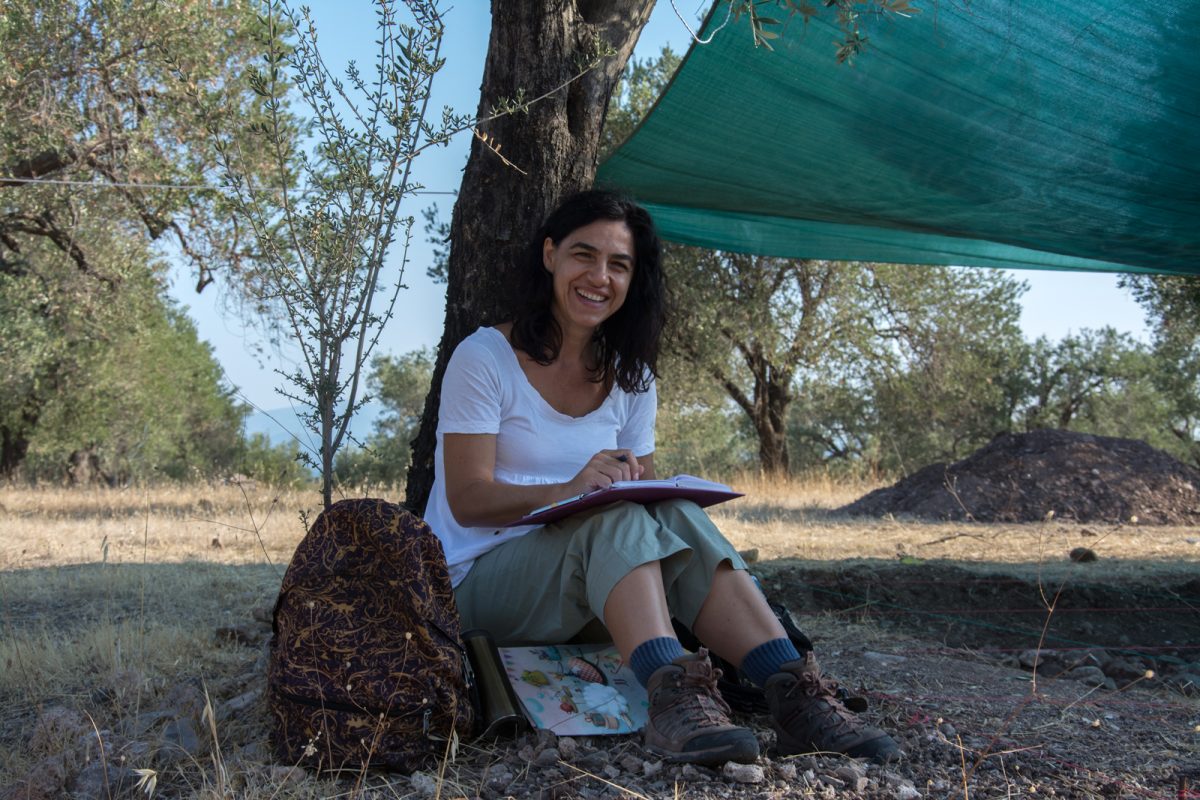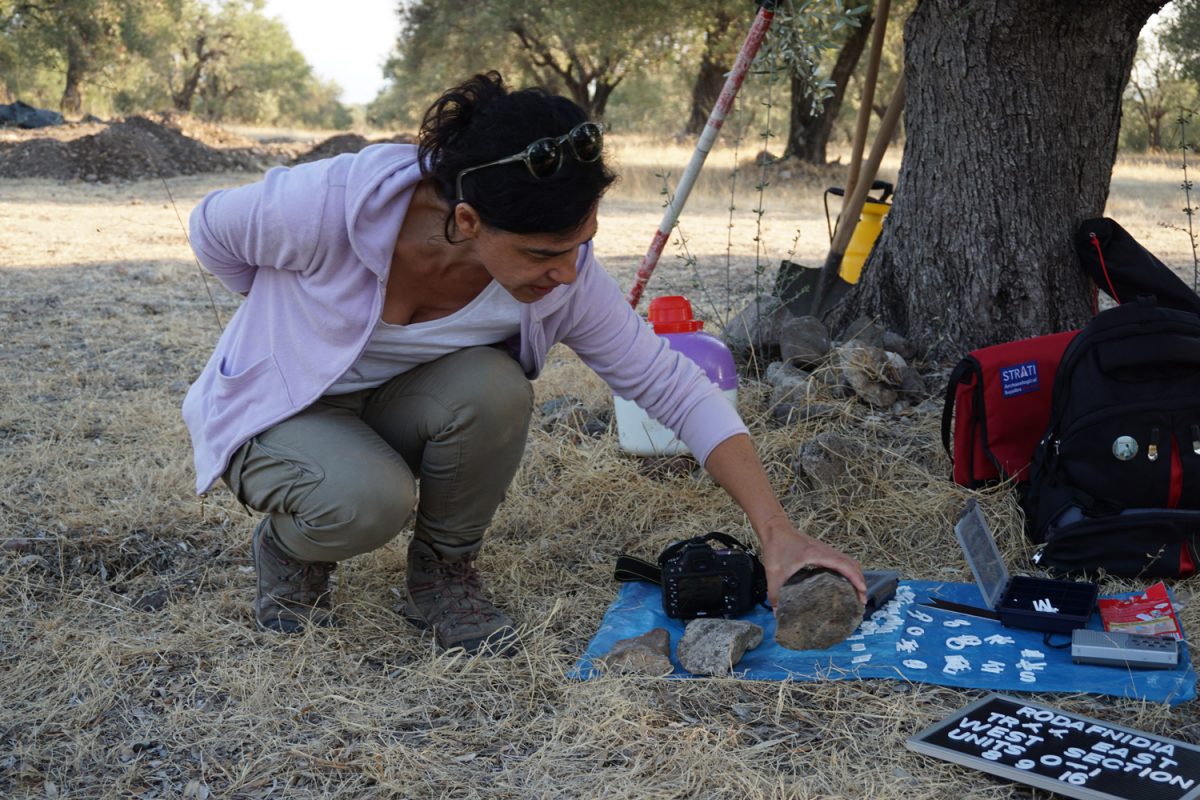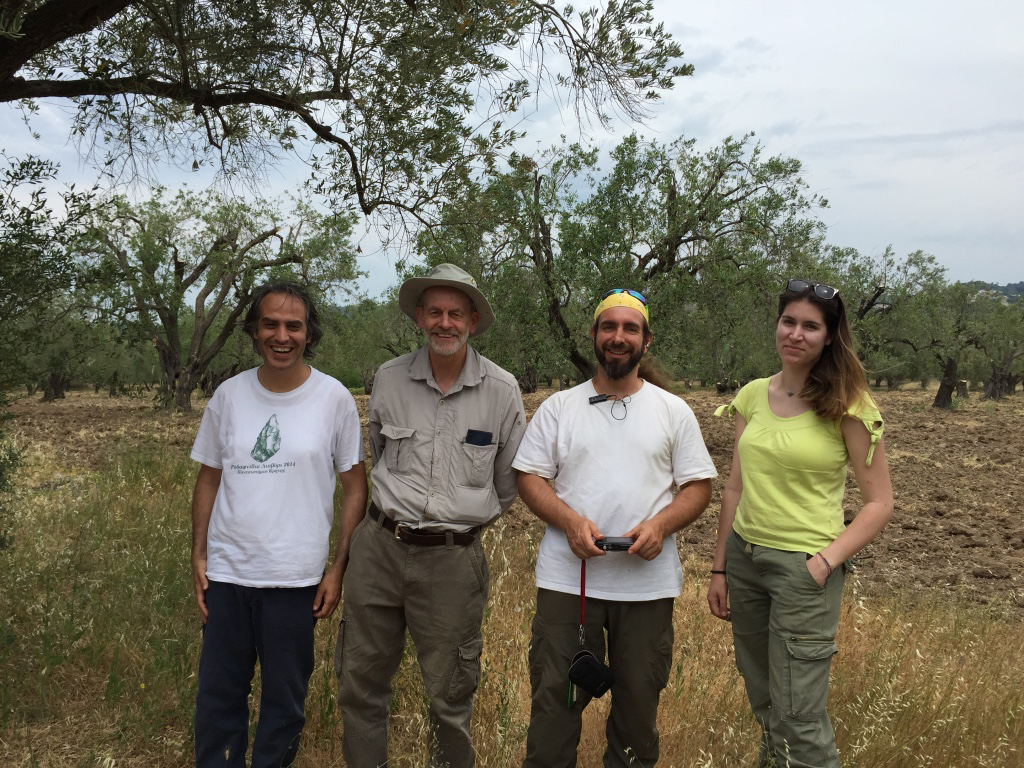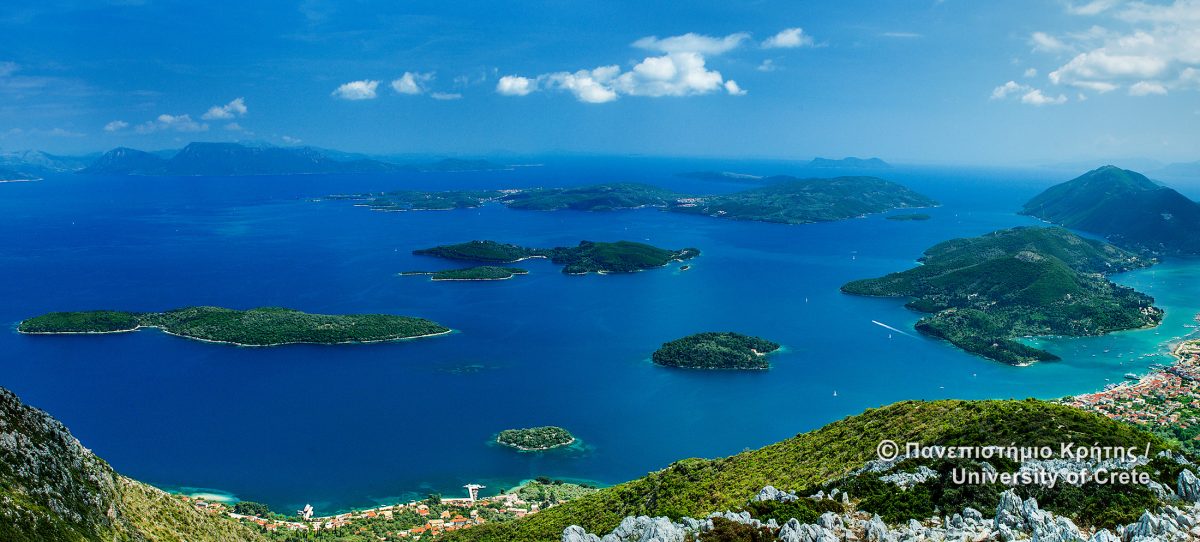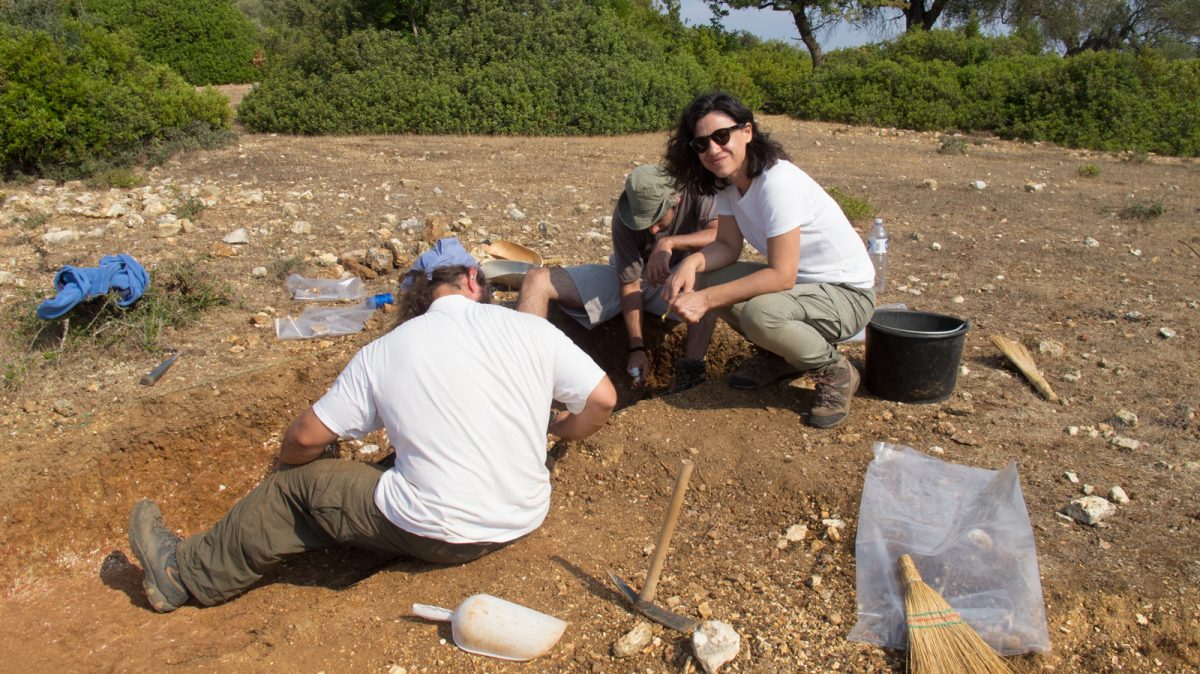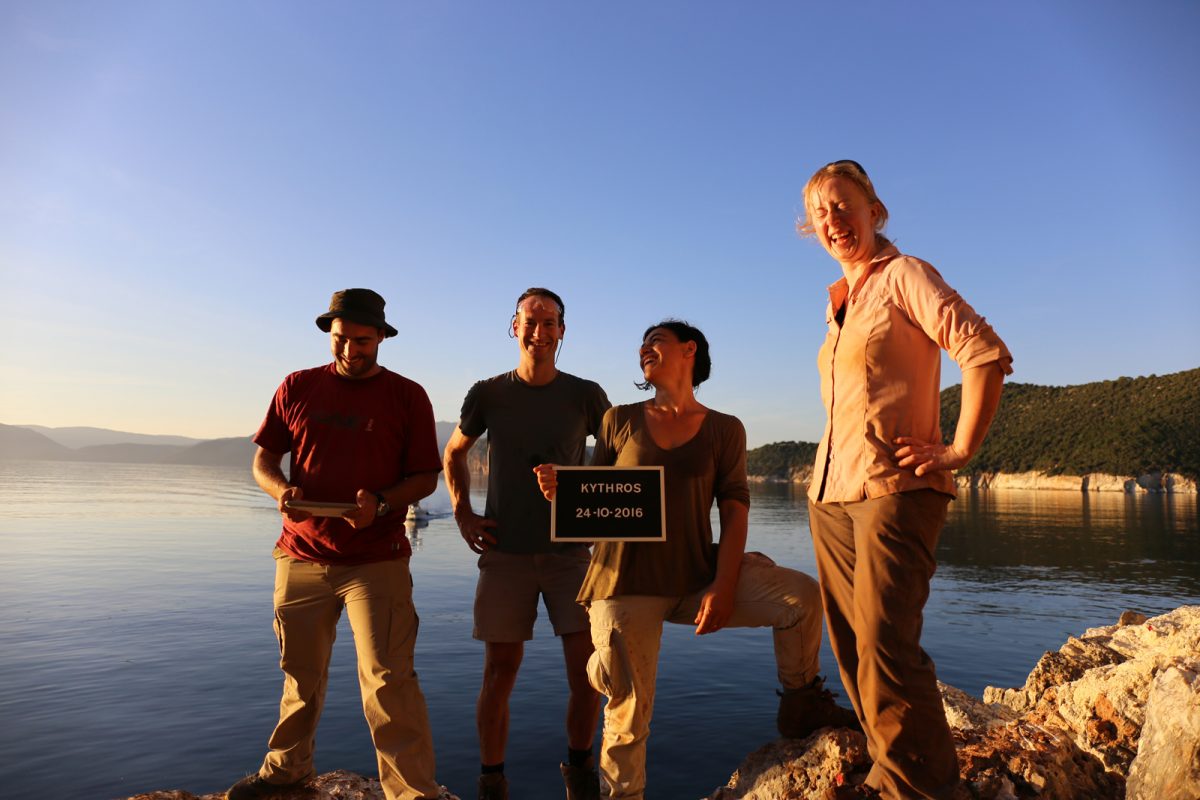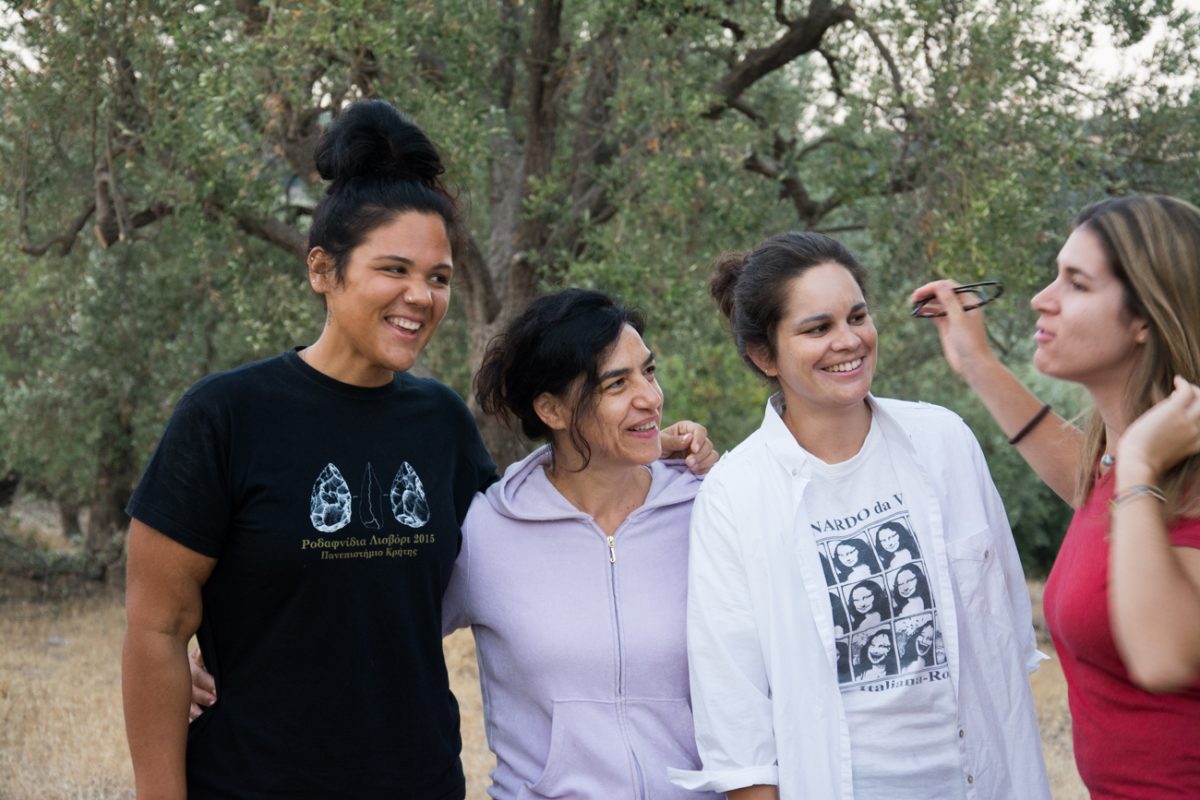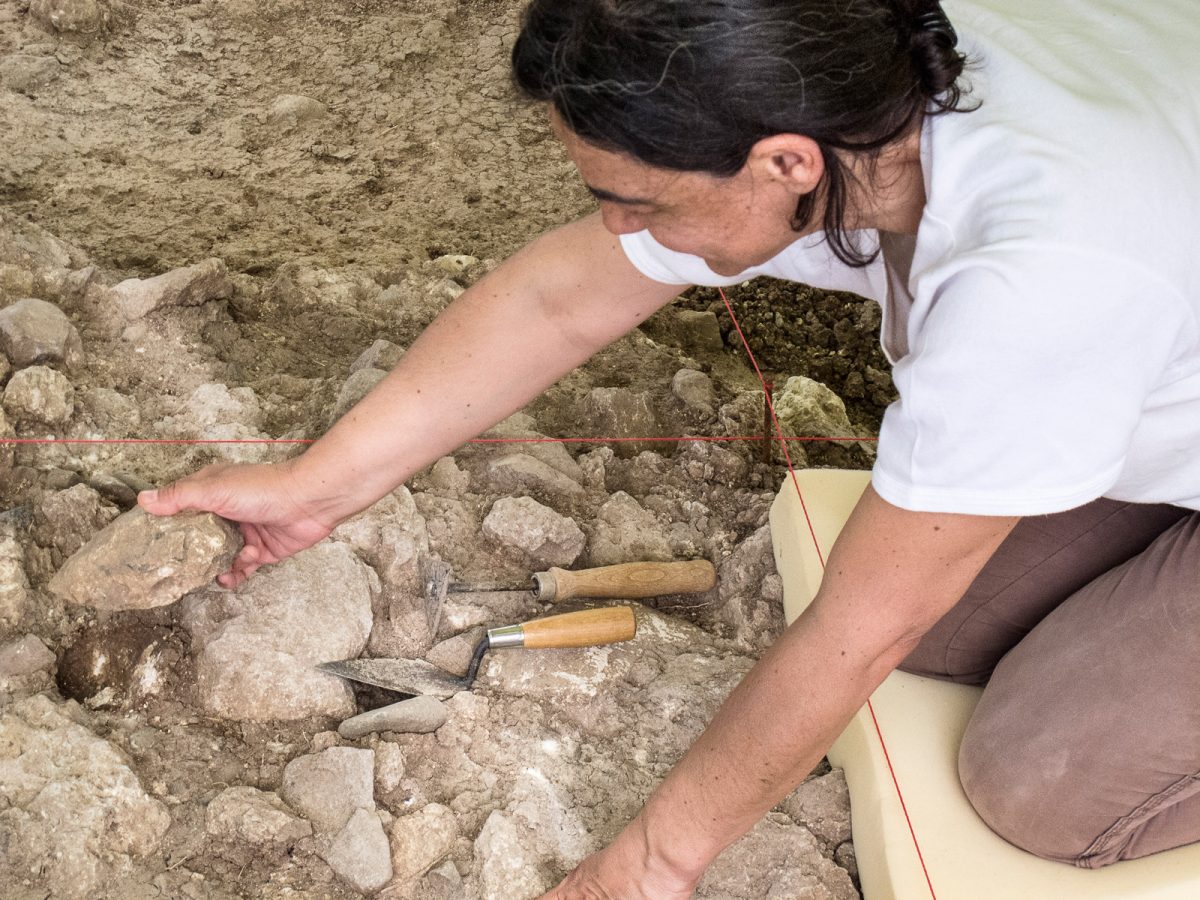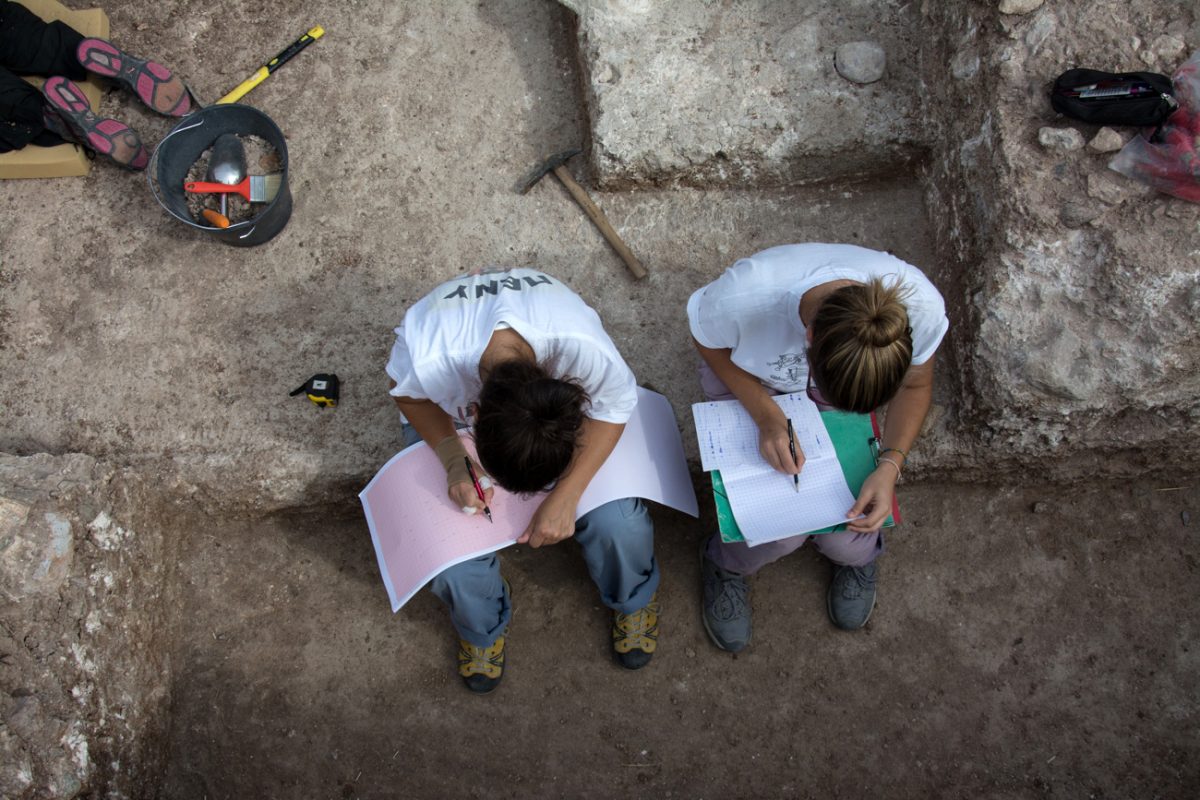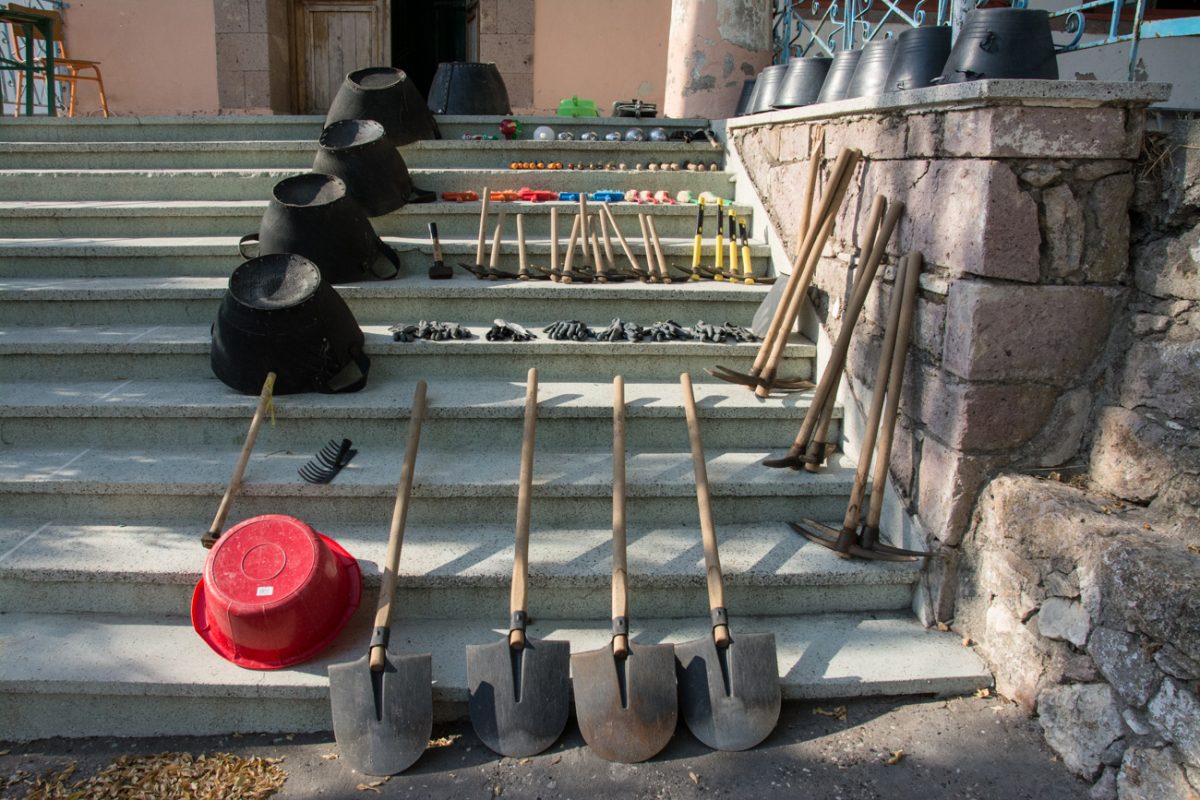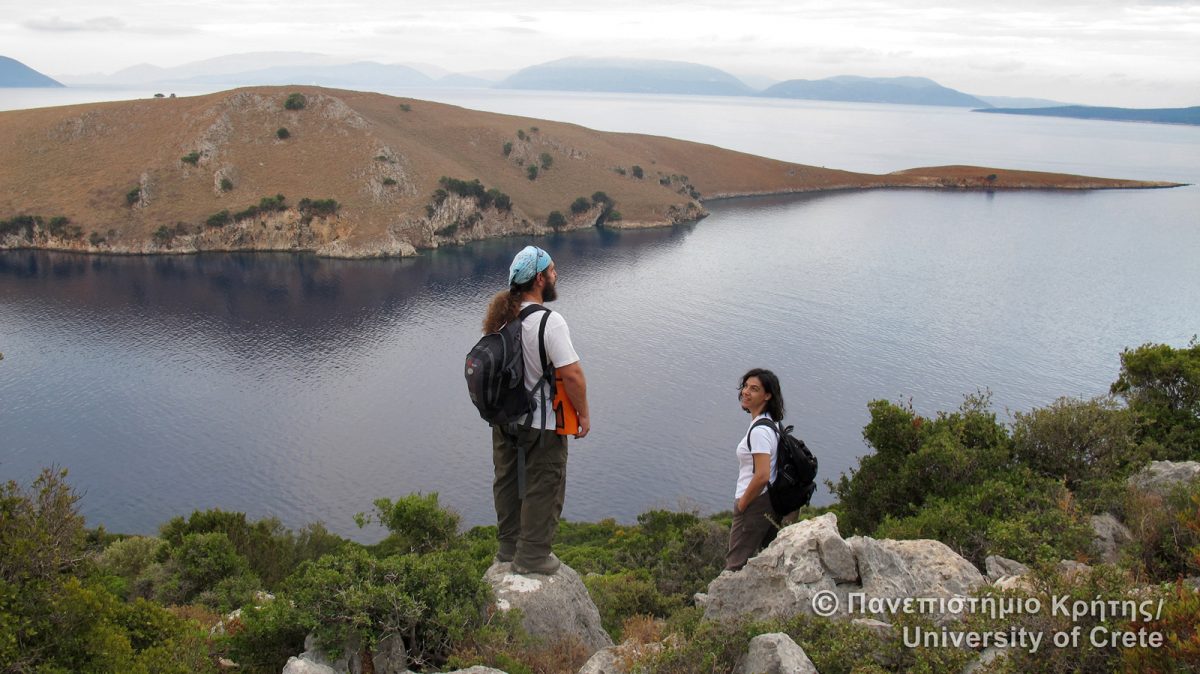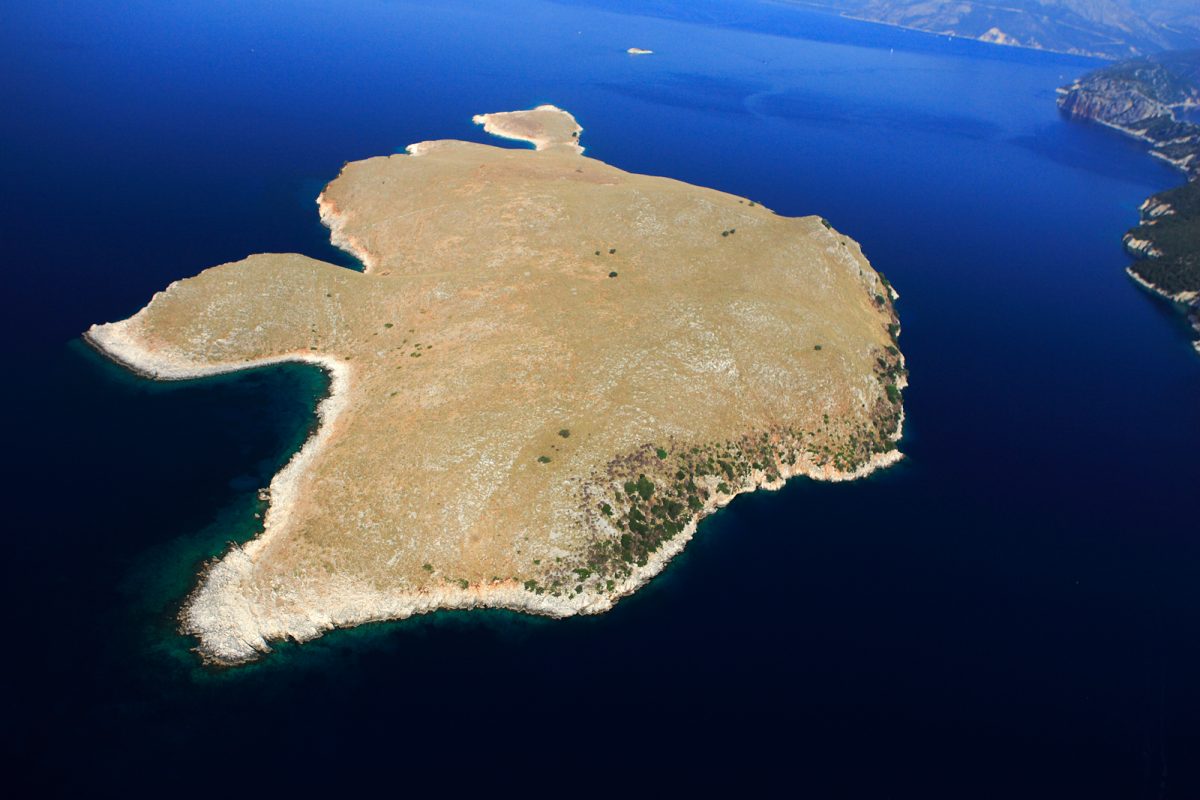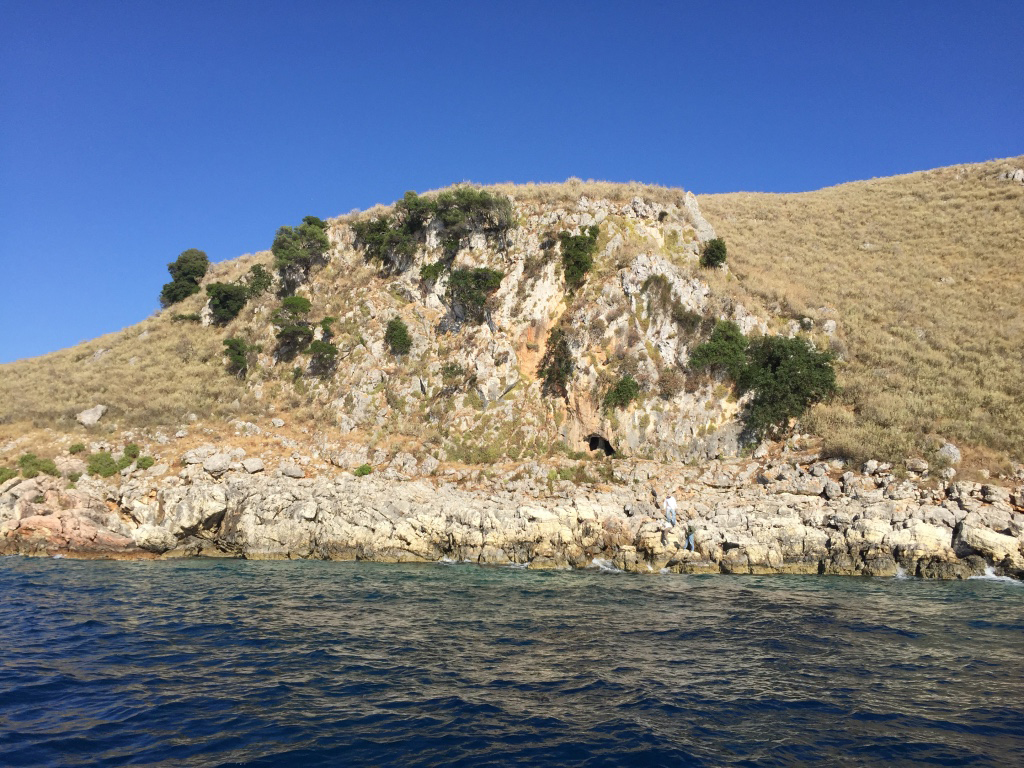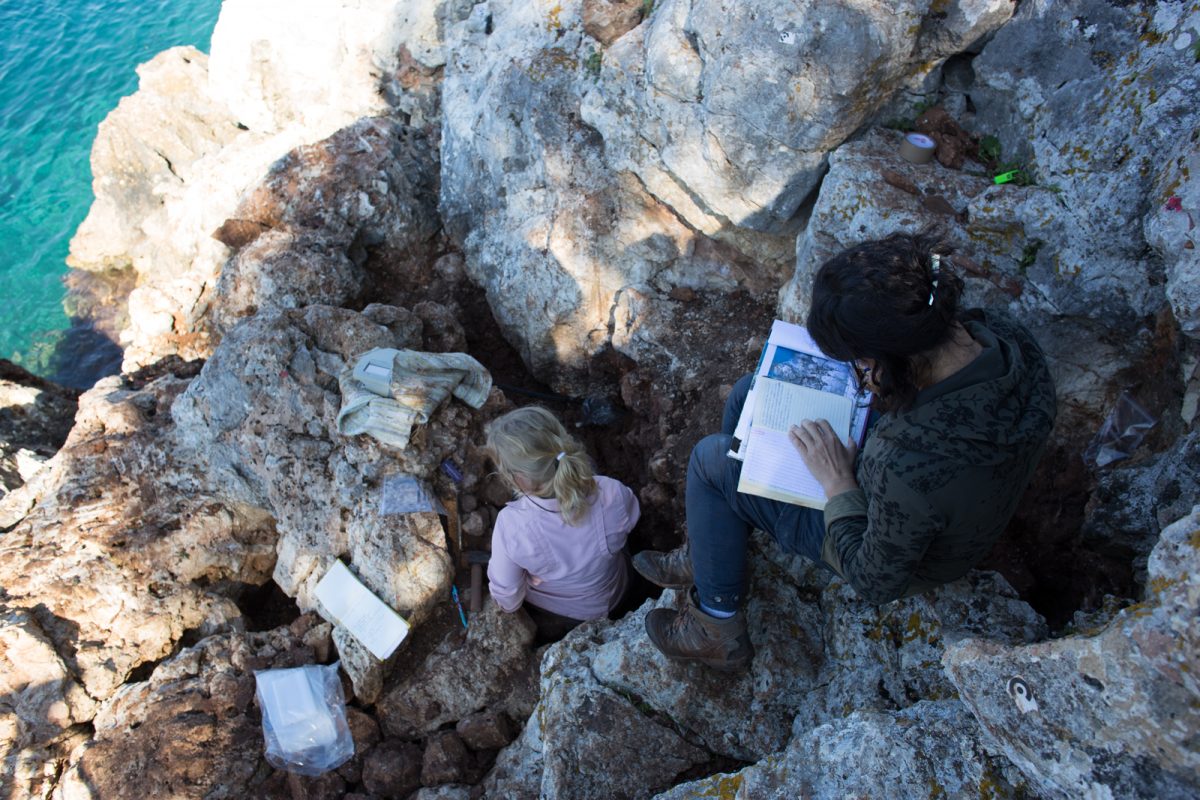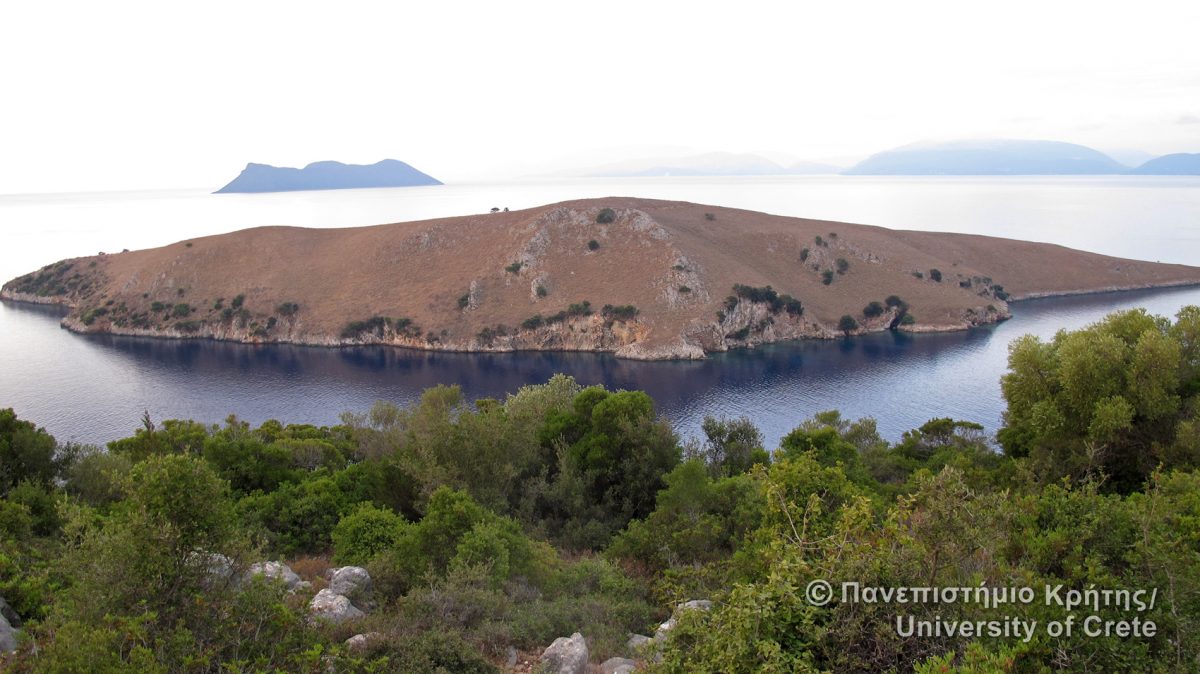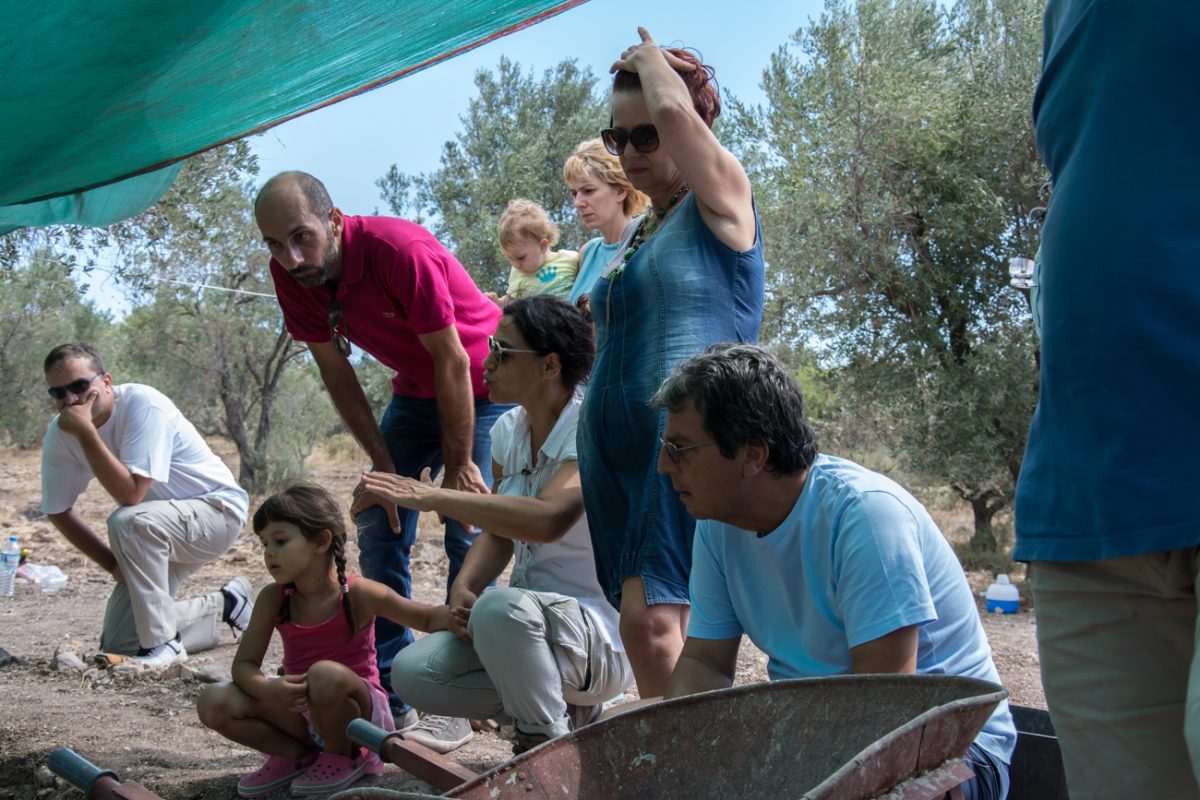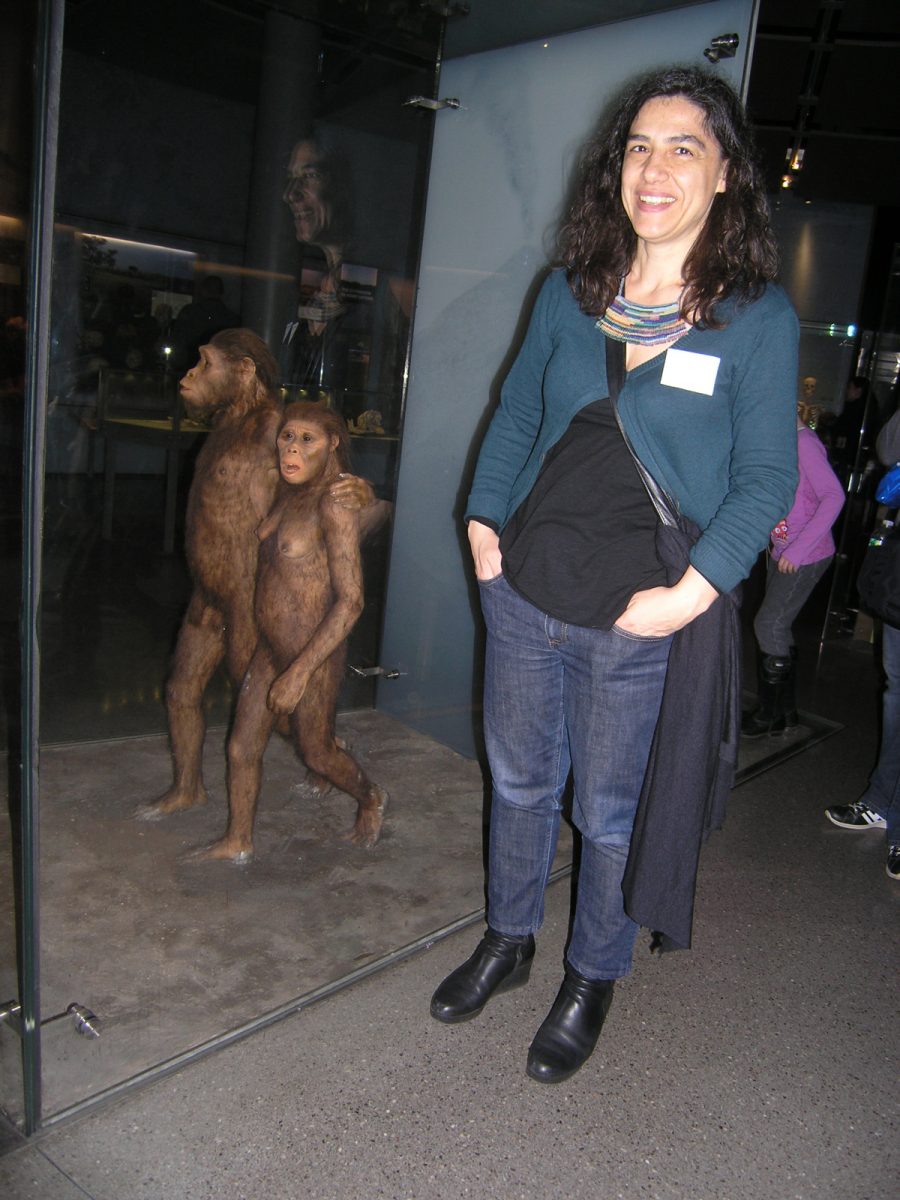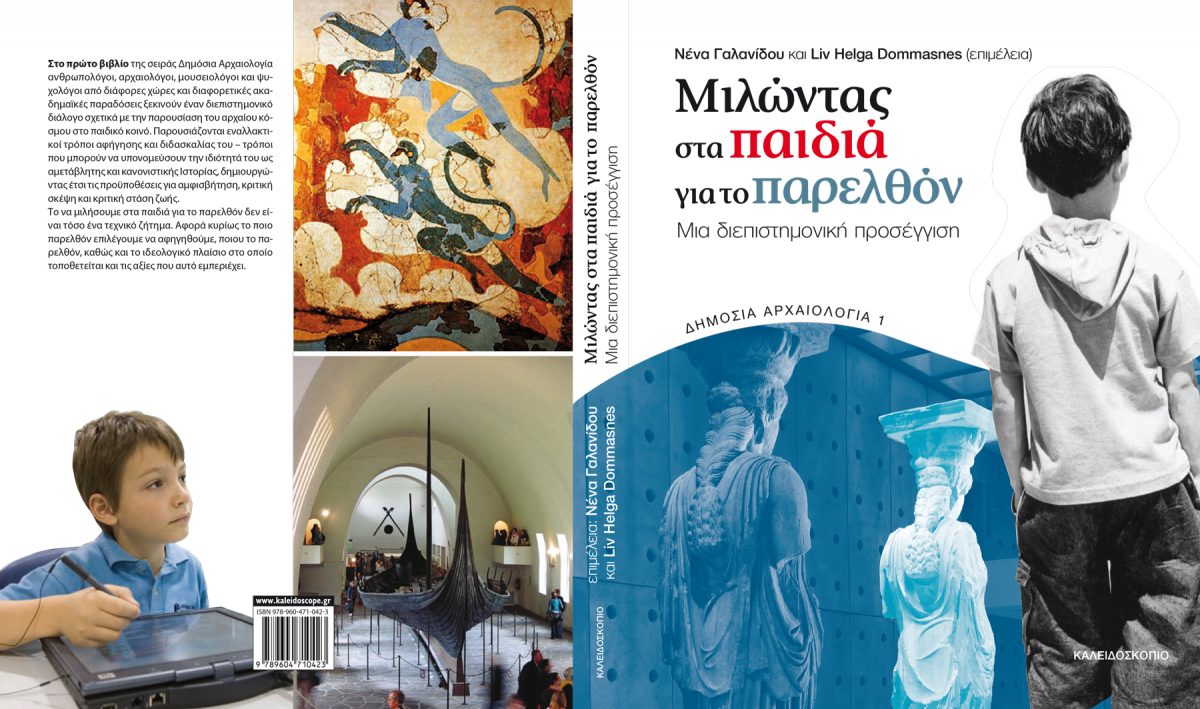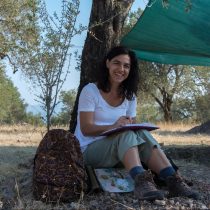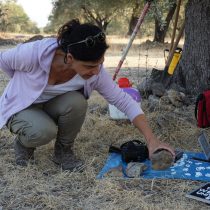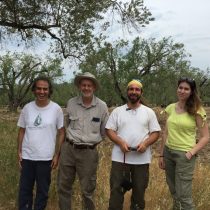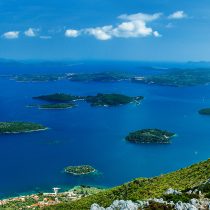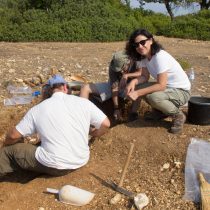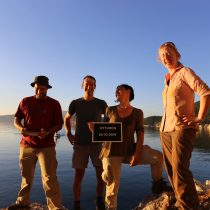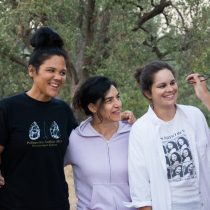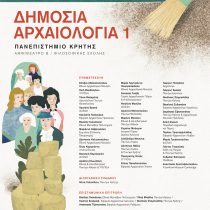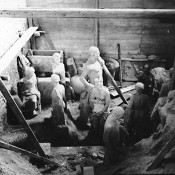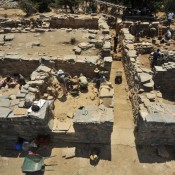On the occasion of the conference on “Public Archaeology” organized by Nena Galanidou, Associate Professor of Prehistoric Archaeology at the University of Crete, we asked her to talk to us about this as well as the course she has followed in Prehistory. Allowing Professor Galanidou herself to describe her scientific course, we shall simply point out her rich collection of writings. She has over 35 articles on the webpage of the Department of History and Archaeology of the University of Crete. Her three independent publications sum up her interests. Her doctoral thesis published in Oxford in 1997 was entitled “Home is Where the Hearth is”. The Spatial Organization of the Upper Palaeolithic Rockshelter Occupations at Klithi and Kastritsa in Northwest Greece (British Archaeological Reports). In 2003, The Greek Mesolithic Problems and Perspectives (British School at Athens Studies 10) was published in London, for which she wrote the introduction and did the editing jointly with C. Perlès. In 2007, she made known another of her “weaknesses” by publishing the book Telling Children about the Past: an Interdisciplinary Perspective (Ann Arbor: International Monographs in Prehistory), jointly with L.H. Dommasnes, Archaeology professor in Norway, specializing in the Iron Age and Gender and Religion Archaeology. The book was published in Greek by Kaleidoscope editions in 2013. It contributed to the Archaeology of Childhood and also launched the new interdisciplinary series “Public Archaeology” of which Nena Galanidou is scientific editor. In the book’s preface she clearly states that “Public Archaeology channels scientific research to the general public, since its main characteristic and mission is to make Archaeology known and accessible to it, the public, by operating as a mediator. […] Nowadays, Public Archaeology embraces and deals with a wide range of issues that arise both where the science of archaeology intersects the public sphere and where it is filtered by it: i.e. issues such as the protection network of cultural heritage through institutions and the public, illegal trafficking of antiquities and smuggling, archaeology’s relations with the media, education and new digital technologies for the transfer of information, to the issue of archaeology as economic capital or its relation with political power.”
Angeliki Rovatsou: Mrs Galanidou, we almost met many years ago, since, as I saw in your curriculum, you worked for a while in the Information Technology Department of the Benaki Museum where I also put in an appearance after you.
Nena Galanidou: I worked at the Benaki Museum from October 1989 to the end of December 1990. Let me tell you how it happened. In 1988, I graduated from the Department of History and Archaeology of the University of Crete and although I wanted to pursue further study on Palaeolithic archaeology, since I had not yet found how or where to do so, I obtained instead a Masters degree in Computer Applications in Archaeology. It was the first year this programme was being offered at the University of Southampton. The departments of Archaeology and Computer Science had joined forces in what was, for that time, an innovative and interdisciplinary curriculum leading to a Master of Science. So I equipped myself with a sound knowledge of new trends in IT and its potential contribution to archaeology that unveils records and studies a great volume of qualitative and quantitative data. As early as 1988, I have had an email account to communicate with friends and colleagues! Step by step I was taught quantitative methods in archaeology and it was there I rediscovered my penchant for mathematics that I had left behind since my school days at the Ralleio. So I complete my postgraduate degree in September 1989 and while I am planning to balance an over intensive academic year with walks in the parks and visits to museums in London, I am informed that the Benaki Museum was seeking staff for the newly established Department of Digital Documentation of its collections. I turned out to be the person they were looking for and I was employed in October 1989.
I worked there but I always had field work and excavation on my mind. So I looked for a way to return to the academic environment and archaeological trenches to do research on the Stone Age. On the one hand I was grateful for being part of a creative working environment, within a living organism whose heart was beating in the basement of the building on Koumbari Street. I was happy to put into practice things I had just learnt. All that was fine, but nevertheless I was suffocating. In the summer of 1990, I took my normal leave and went on a month’s dig to Choirokoitia in Cyprus, and then I also took ten days of unpaid leave to rest. I felt that “a museum is wonderful but… what I want is field archaeology”. And finally I succeeded. I had applied and been accepted at three Universities, Liverpool, Southampton and Cambridge; in fact I had a scholarship for two of them. John Gowlett, Clive Gamble and Geoff Bailey who had accepted to supervise my PhD, were leading figures in the Palaeolithic, the second generation of British archaeologists to be active in research on Palaeolithic Greece. It was a difficult choice to make, in which I was helped by Uncle Stephanos, a second father to me. I also talked to Angelos Delivorrias from whom I learnt that his “first love” before Classical Archaeology was Neolithic Archaeology. He had said to me at the time: “I understand; on the one hand, you have a good job here etcetera, but when it comes to risk taking and passionate interests in things, it’s your choice and you must follow your heart.” On January the 1st 1991, I was starting my doctoral thesis at the University of Cambridge, supervised by Geoff Bailey. I had received my baptism by fire with him on a Palaeolithic excavation at Klithi, a unique rock shelter in the Vikos Gorge. Since then we have had an enduring relationship of mutual respect and intellectual rapport.
A.R: What was the topic of your thesis?
Ν.G.: The Upper Palaeolithic use of space in cave sites. In the thesis, I brought together three themes I was fond of: the archaeology of Prehistoric hunter gatherers, architecture and mathematics. Using archaeological material from Epirus and Bosnia, I examined the origins of architecture: If and when some structure is identified in an otherwise unstructured space. The caves and rock shelters offered a natural shell for protection, which varied in the area available or in the constraints present. What I examined were the similarities and differences in the distribution of finds on the living floors and round those elements functioning as the “site furnishings” (e.g. rocks falling from the ceiling, hearths, walls). The study found that in this early use of space, hearths acted as the primary cohesive elements in spatial organization and activities of the social group. Within the limits of their territory, Homo sapiens groups applied the same principles of spatial organization to different sites. Depending on the group’s activity and social composition, variability appears; this is, however, variability on the same basic theme. The title of my first book originating from the doctoral research is Home is where the Hearth is.
Α.R.: And after the doctoral thesis?
N.G.: A postdoctoral fellowship at Clare Hall, Cambridge, from October 1996 to December 1999. I participated in the competitive selection process (with many fellow candidates from the humanities and social sciences). I had to convince the College panel, which I did, that I must take this position reserved for young researchers. The stipendiary research fellowships give them the opportunity to do research and teach without the worry of having to earn a living. During that time, I taught Quantitative Methods in Archaeology and Mesolithic Archaeology courses to the demanding audiences of Cambridge undergraduates of the Archaeology Department. My strengths were really challenged.
Being offered this platform to elaborate on my doctoral research, publish it and establish my scientific profile in an academic environment that warmly welcomes original thinking, without prejudice, based on excellence, has since been deeply inscribed in my code of values. Positive reception of young researchers with talent, knowledge and an appetite for hard work is a desideratum for the Greek academic and research institutions. Out of this nurturing, the human resources needed for the day after the crisis in our country will emerge. Likewise, those who excel in the arts and humanities will also be pioneers of “change”, a meaning so misunderstood in modern Greece.
My ten-year tenure in the British academic system (also perhaps my refugee origins), made me have no regrets on the hours spent working. When you love what you do, it doesn’t tire you. On the contrary, it rewards you with satisfaction and peace. Destination is of course also important; but it is mainly the journey that counts. In all the ten years of my life in England, I was certain my destination was to return to Greece.
Α.R.: When did you return to Greece?
Ν.G.: Christmas of 1999, seven months pregnant and having applied for an Assistant Professorship at the University of Crete. I was offered this job two months later and three weeks before the birth of my first daughter.
Α.R.: The Department of History and Archaeology of the University of Crete has, among other things, also posted your current research programmes in Prehistoric Archaeology that extend all over Greece.
Ν.G.: I specialize in Stone Age Archaeology. I have published on Mesolithic and Neolithic Archaeology, yet I have a soft spot for the Palaeolithic Archaeology. The archaeology of nomadic people of the Pleistocene, who subsisted by means of hunting, fishing and gathering plant foods (vegetables, bulbs, seeds and fruits). The nomadic life of the object of study makes Palaeolithic archaeologists also “nomads”. I am one of them. This, if you like, explains the fact that one moment I am in Kastoria, the next in Thesprotia, Lesbos, Lefkada or Crete. All my quests have as common denominator the archaeology of highly mobile prehistoric groups. They moved seasonally, following their prey and the cycles of availability of other foods. But it was not just the food or other natural resources necessary for their survival that dictated their mobility patterns. Critical to sustaining the Palaeolithic communities were the social life cycles, comprising great meetings, smaller gatherings and rites of passage.
So my research ‘home’ is where an early site is. Hence the absence of geographic focus in my investigations that are conducted both on mainland Greece and the islands.
The research programmes in Macedonia and Epirus belong to the first groups. The study of finds from the Lake of Kastoria began with a visit to George Chourmouziades, the archaeological site and its reconstruction at Dispilio. Chourmouziades who had a significant impact on archaeology, was an open, generous spirit. So when I visited him in Dispilio he said to me “Nena, you must see the material found by an antiquities keeper from the basin of the Lake we believe to have Paleolithic artifacts. Pantazopoulos has been trained in our archaeological trenches and identifies stone tools. In the winter when we are not digging, he conducts autopsies between Dispilio and Ampelokipoi, collects stone tools and has made a collection that he has handed over to the Ministry of Culture”: These finds had been stuck onto plexiglas and Palaeolithic tools were among them, so naturally I accepted the invitation. I recorded the collection, studied it, published it and so I found myself talking about the Neanderthals of Macedonia. Chourmouziades was my connection with that part of Greece. Björn Forsén, professor of the University of Helsinki and former Director of the Finnish Archaeological Institute in Athens was my respective connection with Thesprotia. He invited me to study material, recovered by the Finnish expedition under his supervision, in the basin of the river Kokytos, i.e. the upper flow of the Acheron. Two doctoral candidates of Palaeolithic Archaeology of the University of Crete and I joined forces with the Finnish team and published our studies in the Thesprotia Expedition book series. In the third volume edited by the head of the expedition, Esko Tikkala and myself, we put together a narrative on the region’s prehistory, assembled bit by bit from excavated and surface material and local traditions of nomadic and settled populations of Epirus.
Α.R.: What about the field studies that you head?
Ν.G.: When both my daughters had grown up a bit, I returned to the field in order to study two missing links in the chain of Palaeolithic Greece; the Archaeology of the Lower Palaeolithic and Island Archaeology. This led me down the unbeaten track of Palaeolithic research in the Inner Ionian Archipelago and Lesbos.
In 2010, we began a surface survey in the Ionian Sea and a small scale excavation in collaboration with the Ephorates of Aitoloakarnania-Lefkada and Kefalonia. Since 2014 the University of Crete has been excavating a Neanderthal cave on Kythros, a small barren island opposite Meganisi. Our work on Kythros is tied together with our long term research in the Archipelago and Lefkada. It has a strong regional perspective. It covers the Akarnanian coast, the islands and the seabed of the central Ionian Sea, combined as it is with the mapping of submerged Pleistocene landscapes we conducted with collaborators from the Hellenic Center for Marine Research.
Since 2012, in Lisvori, Lesbos, we are systematically unveiling the first extensive Acheulian site in south eastern Europe and western Anatolia. On the banks of small rivers and the shore of what was a big palaeolake, the Kalloni Gulf, we are unearthing stone tools that belong to that centuries old technological tradition. Our finds link early Aegean archaeology with the corresponding archaeology of Africa and Eurasia. From our work a new scenario emerges for the early colonization of Europe: half a million years ago hominins walked into Europe via the Aegean Basin, during periods of low sea level stands.
Both research programmes rely on funding from Greece (University of Crete, Region of the North Aegean, Municipality of Lesbos, Municipality of Meganisi, Secretariat General for the Aegean and Island Policy) and abroad (Wenner-Gren Foundation for Anthropological Research, Honor Frost Foundation) and sponsorships from the business sector (Aegean Airlines) and public benefit foundations of a cultural nature (J.F. Costopoulos Foundation). They are realized by international groups of scientists from different specialties, because Palaeolithic research requires an interdisciplinary approach. These programmes train students from Greece and Europe in methods of field research and initiate them into the magic of Palaeolithic Archaeology.
Α.R.: How did you locate these sites?
Ν.G.: Each site has its own research history. In an article of his in your journal (Archaeology and Arts, issue 9, November 1983) called “The Gardener and the Wayfarer”, Chourmouziades wrote: “Whoever does not know what to do with his observations, observes in the wrong way. The gardener looks at his apple trees more carefully than the wayfarer…”
The second period of my life at the University of Crete, as a professor, is inextricably linked with the systematic teaching of Palaeolithic Archaeology. My classes (in the amphitheatre, the laboratory and in the field) aim to equip the students with the Palaeolithic Archaeology basics. This is a condition for the map of Prehistoric Greece to change. The Greek landscape is dotted with Palaeolithic remains. There is a need for people trained to recognize, study and incorporate the remains in the narrative of Greek Prehistory. Teaching is one of my favourite things. It never ever tires me, because it’s something I love and care about. So I teach my students how to distinguish a stone tool from some naturally broken cobble, the criteria to place it within a Prehistoric technological or cultural tradition, whether a landscape could have supported a Palaeolithic settlement, or in what geological deposits should “the wheat from the chaff” be separated. How from being mere “wayfarers” they can become “gardeners”.
Palaeolithic Archaeology begins 3.2 million years ago and ends 11,700 years from the present day. It is referred to in time scales that are large and mainly asymmetrical. It is linked with different species of hominins who emerge, leave their cultural imprint and become extinct. The beauty of the otherwise “humble” Palaeolithic record lies in the cultural and biological diversity it identifies. On the Voidomatis river and the banks of Lake Pamvotis in Ioannina, we were studying Upper Palaeolithic remains left behind by Homo Sapiens groups. In Thesprotia, Lefkada, Meganisi and Kythros we are working with Middle Palaeolithic remains left behind by Homo neanderthalensis groups. On Lesbos we are studying much older finds left behind by more ancient hominins. All these, their material culture and us, archaeologists, all fit under the umbrella of Palaeolithic Archaeology. And just as Palaeolithic Archaeology in Greece grows, matures and changes, so do we archaeologists change, in a fruitful union between the subject and object of research. Our knowledge of Prehistoric groups in Kythros and Lesbos deepens, as we, the subjects of archaeology, also change and mature.
Α.R.: I have read that both the islands of Lesbos and Lefkada were at one time part of the mainland.
Ν.G.: Part of the Palaeolithic heritage is no longer visible since it now lies on the sea bed. Mapping it is part of a new research direction I have taken lately, because of my interest in the islands’ early record. I want to understand how Pleistocene submerged landscapes changed, as the sea level changed, when terrestrial bridges were opened, creating proper conditions for populations of the Pleistocene to settle and migrate.
This field is tremendously interesting. What is archaeology? Archaeology is the study of the history of humanity, of human societies, through the material remains they have left behind. It is a science that has just as much material as historical and anthropological substance. Even though our finds are the words of a sentence, the order and syntax of these words ‒ultimately the sentence’s meaning‒ is conditioned by social relationships, a group’s dynamics, time, climate and the geography in which human activity takes place. In other words, it is framed by context and environment, social and natural. In Palaeolithic Archaeology ‒and not only in that case‒ “interpretation” presupposes that we understand the stratigraphy, obtain absolute or relative dates, evaluate the depositional processes and come to grips with the palaeogeographic conditions. Your question refers to the palaeogeography chapter.
The Pleistocene, the geological subdivision of the time to which Palaeolithic Archaeology refers to, is also called the Ice Age. However, not all of the Palaeolithic period was a long “winter”, there were also “summers” in between. We can follow the climate change and it is of great interest to us because we want to bring into focus how hominin groups responded to them. How did their living space change? How did their dispersal patterns change? How did they go about harvesting natural resources dwindle or grow? Were new routes opened and old ones closed, how and where were conditions created for settling?
Palaeolithic Archaeology develops a close symbiotic relationship with Quaternary geology and science, so as to seek out the nuances of settlements ‒ the life setting, to speak of. Here climate and environment have an input. Examining the hominin adaptation in the context of the cycles of climatic change or in the local microenvironments is a major aim. And thus the seabed comes into focus. During glacial periods, the global sea level dropped because the oceans’ waters were locked in the icebergs. There were periods when the sea level dropped by as much as 120 metres. Can you envision this? That many of today’s islands are the peaks of the continental shelf. During the glacial periods, many were joined to themselves and to the mainland. The islands of the Ionian Sea and the islands of the Eastern Aegean were occasionally joined to mainland Greece and the Asiatic coast respectively. Imagine the archipelagos of the Eastern Aegean and that of the Ionian Sea as being like a team of swimmers who are holding hands under water and all we can see today are their heads above the water surface.
We know therefore that in some periods of the Palaeolithic, parts of dry land were revealed that were lived on or crossed by populations of animals or hominins. It follows that Palaeolithic Archaeology of the islands does not necessarily have the same aims and methods as Island Archaeology of the Bronze Age, or of the Historical times when the sea had reached its current level and the islands and coastline of Greece had their present form.
Archaeologists, geoscientists and cultural heritage specialists join forces and make a strong case for Continental Shelf Prehistoric Research. The new sub field has historical questions as its starting point, it collects and evaluates all information about submerged landscapes and incorporates this information in the Palaeolithic narrative.
Α.R.: And how does this subfield relate with Marine Archaeology?
Ν.G.: Sea bed mapping constitutes a new chapter in Marine Archaeology. In this case, shipwrecks are not the object of research, neither are nautical history, maritime contact and trade. The challenge lies in reconstructing coastal palaeogeography and the affordances of the now submerged landscape. The location of a gully, a water spring, a cave, even though these are now on the seabed, sheds light on the landscape’s capacity to support foraging communities. Greece has been a pioneer regarding the means and techniques that make this research possible. Human resources from the Departments of Geology and the Hellenic Centre for Marine Research are in a creative dialogue with the community of pre historians. Allow me to add that apart from archaeologists, marine scientists are one more of Greece’s comparative advantages. This emerging field of research unites two research communities.
The path was opened by an interdisciplinary network of scientists funded by the European Union through COST. When this ended, it gave its place to the SUBLAND team who jointly wrote Land beneath the Waves. In this book we try to make a case that this research deserves attention and funding. You and I won’t go diving with a mask; marine scientists will conduct the study. We shall evaluate their information, the sea-bed maps. And we are not referring to mere bathymetry but to palaeogeographic reconstructions. We’ll say that here was a gully or a fresh water spring, a river passed through there. This piece of geographic information is of great value to pre historians. It helps us understand the palaeo environmental conditions available to Palaeolithic groups to settle or disperse. Most of today’s islands have a limited bearing capacity, being cut off from large mainland regions for their supplies. I, for instance, am now digging on a very tiny island, a dot in the middle of the Ionian Sea.
Α.R.: Is that Meganisi?
Ν.G.: It’s Kythros, right across from southern Meganisi. On its steep rocky coast facing Meganisi, there is a collapsed cave yielding Neanderthal archaeology. So what did Neanderthals do? Did they cross the sea to get there? They had a large brain, so they could have gone.
By mapping the sea-bed we aimed to understand when terrestrial bridges were opened, bridges that allowed Neanderthal groups to walk there and to the other islands of the archipelago. And actually it does seem that they walked to Kythros. But they needed a boat to get to other islands. In the central Ionian we are studying the beginnings of navigation in a closed and well protected sea where your destination, the next piece of dry land, is visible and requires that you cover relatively small distances by sea. It’s magical to look at the sea and imagine it all as land. I don’t know why but it’s magical and worth sharing with us! Maybe it’s slightly perverse seeing an endless blue expanse as brown, grey and green, but it is certainly an alternative way of escaping into the past.
So this is quite a dynamic trend emerging in current research and I am happy to be part of it. I’m a part of those who conceived it and are trying to make it known and convincing. Things are not so simple, though. The first thing someone says to you is: “But the costs are enormous! What is it we’re going to do? Map the European continental shelf? We haven’t even protected other monuments yet? etc”. But this part of our research helps us to think holistically, see the bigger picture and also think beyond and outside today’s national, administrative or other boundaries, beyond and outside everything that separates us. That’s why I ’m devoted to Palaeolithic Archaeology. It offers us another type of knowledge about our country, associated with human nature that is common to us all. Palaeolithic heritage is the common heritage of all mankind and it is this greatness that especially attracted me – that is why I left the excellent job at the Benaki Museum!
Α.R.: When talking about Public Archaeology, you mention somewhere:“The narratives of Public Archaeology sometimes leave its public indifferent and sometimes thrill it, at times they charge it ideologically and at times motivate it to reflect.” And you use Vergina as an example. What can you tell us about Amphipolis?
Ν.G.:There are at least two sides to this issue. Its one side is purely scientific and I have nothing to say, because there are specialists who are in charge.On the“Issue of Amphipolis” in the public sphere, I want to say that it was a great success on the part of my colleagues to get the whole of Greece talking about archaeology, despite the uses any archaeological find will always be subjected to, uses that are ideological and political. Amphipolis shows archaeology’s power to stir a wide public. At the same time, it shows that archaeology provokes big ideological and political conflicts and can become a vehicle in manipulating public opinion.
Α.R.: Especially up north, certainly.
Ν.G.: In the whole of Greece. I consider the first as positive, i.e. that archaeological research was grafted onto daily life. On the other hand, the archaeological community is responsible for setting the limits and protecting its finds from ideological and political uses. Being an archaeologist, I know that one always needs more time; it is always necessary to cast a second or third glance, to reexamine facts, to calmly compare them. It puts a lot of pressure on you, if you are digging with cameras behind you. An excavation requires concentration, one gives oneself to it like a love affair. In the case of Amphipolis, on the one hand, it was our gain that everyone was talking about archaeology and everyone was interested in “how it went today” and “what finds we had”. On the other hand, it created a tremendous pressure for “fast results” and an ideological distortion. This was the price paid for important field research being transformed into a popular narrative. I don’t condemn Amphipolis, however, even though it divided the archaeological community and beyond that. It is a great monument, whatever its age, and it waited so many years. So shouldn’t we acknowledge this woman archaeologist who brought it to light?
As you may know, being exhibited in the public sphere is often carnivorous. You are taken and lit with such powerful spotlights that they may burn you and then you’ll become easier prey. Nevertheless, beyond the ideological use, it’s worth seeing the other positive aspects of the very complex “Amphipolis” phenomenon. Research started on an important monument, the public at large got involved, funds were found for the research. These funds must be distributed in a proper way and not in a ping pong game of ideological revanchisme from Amphipolis to Vergina and back again. Let us archaeologists also be careful of what we say and when we speak to the public at large. How do we ultimately accomplish Public Archaeology? It is our responsibility to convince the public to embrace the monuments. Because when the archaeologist doesn’t speak, it’s the journalist, who will, the blogger, or the mayor; everyone who thinks they has something to say.
Α.R.: You say somewhere else: “Archaeology’s great strength is based on the material nature of its finds which originate from past civilizations and this strength multiplies when it encounters one’s existential quest and one’s inquiries into his/her identity and roots”. I should like to ask you about the relationship between archaeology and people, when the antiquities are in places inhabited by people who have neither roots nor ancestors there. I am not just thinking about the ISIS in Palmyra. I also imagine that Seljuk Turks once settled in Asia Minor next to a Hellenistic temple. What sort of relationship with the antiquities is created then? How “western” is your point of view?
Ν.G.: One of the books we are preparing for the series Public Archaeology is called History’s Eraser. Monuments Erased from the Cultural Heritage List written by Kyriakos Psaroudakis and Sophia Spyropoulou. It addresses the complex and topical subject of the deliberate destruction of monuments and works of art in the history of civilization and the coordinated effort to obliterate history, wherever a competitive relationship intrudes on the past and its annoying remains.
Your question touches on our need to seek out our roots in one way or another. The way one understands the meaning of homeland, the use of language, the function of religion, a circle, a group, a company of friends even a family photograph album constitute elements of individual and collective identity. Nowadays, identity is also served by the progress made in genetics, opening a new chapter. For a few dollars you can give a sample of your DNA and buy the necessary services online for seeking out your genetic tree. Something very simple that answers precisely to this need one has to find one’s roots.
Examining issues of identity is not only the field of archaeology, history and social anthropology. It is approached by many others and where there are gaps, these are filled by the free economy creating products we had never imagined. Allow me here to make a personal confession. By specializing in Palaeolithic Archaeology, I’m essentially taking a leap, going beyond the differences and reaching our deep roots to those things that unite humans as a species, as a common heritage before today’s national, linguistic, religious, class, race or gender differences. When referring to Neanderthals, we Europeans now know that they contributed to our ancestry. Whether we portray them as noble savages or as short, robust women, we must come to terms with the idea that they are part of our common European heritage and a part that didn’t manage in the evolutionary sprint forward. So, in that respect, yes my point of view is always western because I carry that sort of baggage. Being western is also deeply humanistic since, through my research into the Stone Age, I am looking for those elements that enriched the common identity of our species.
Archaeology always fueled discussions on identity and otherness, often charging them and triggering ideological, nationalistic and political uses and abuses. The distance is negligible between the star of Vergina and the occupant of Amphipolis. We are however in a period where everything is changing, the large-scale population movements of Africa and Asia are undermining the anthropogeography of Europe. Human communities were always mobile and this is what Prehistoric Archaeology narrates to us. At present, everything is in a period of transition and change. I shall give you an example:
I was talking to a colleague from Spain, on a recent journey I made to Sweden. This colleague has studied in England and France, she works in Sweden, she has adopted a child from Ethiopia, her partner is a German archaeologist who has two children growing up in Sweden by his first wife who is Dutch. The German-Dutch children have an Ethiopian half brother whose first language is Catalan, all three have Sweden as their country and school mates and neighbours who come from Greece, Syria, Afghanistan, and Iraq and have settled in southern Sweden. The children of my colleagues, of the economic immigrants and the refugees belong to different “races” of the European and global family, they have different mother tongues, different bio histories, but at the same time they all live in an environment in which they are allowed to study, work and flourish. They shape a fresh identity in the new country they settle in. What has been left of yesterday in this identity and how are today’s inputs grafted on to it? It changes with the huge population shifts, with the digital revolution, with the resources you now have to connect and communicate. And a crucial issue that now contributes to shaping identity is accessibility to the society of information and the society of knowledge. New analytical and interpretative tools are already needed when examining identity.
Homelands change, homelands are reborn, we carry homelands in our hearts and minds and it is very important to give the new generation tools to be able to face present and future challenges wisely, mildly and with an open mind. Respect for cultural diversity and intercultural understanding are key concepts in this discussion. The big challenge in education (of children and the young) and continuing education (for grownups) is cultivating a critical approach, tolerance, and compassion; to offer roots and wings at the same time.
Α.R.: Social archaeology and the social construction of gender are among your interests. Would you like to say a few words about them as well?
Ν.G.: They interest me very much and this is something also related to my own history, particularly at the time I had given birth to my daughters and was breast feeding them, which meant I had to stay away from field research. I also arrived there through awareness and a social and political quest and because I spent a phase in my life shut up at home and I was very interested in seeing what sort of material culture is produced and what material remains are associated with children today as in Prehistory. I therefore felt the need to turn to the archaeology of childhood, since an archaeologist filters everything in the light of her subject. As you know, in today’s market there is an entire section of the economy associated with maternity and baby products, from mums’ bags to electronic spies and from high tech teats to super prams. The way in which modern western society approaches children is not the same as in the past. On the contrary it is completely different. For the chapter on “childhood” I started my reading from studies of social anthropology as well as the great writings on the infant’s development and children’s education…
Α.R.: Is this what we call “archaeology of childhood”?
Ν.G.: … And from there I came to archaeologists’ writings on children. Childhood archaeology is an organic part of social archaeology. Through archaeological remains, you systematically try to identify children as a separate social category. For very many years archaeology was the narrative of great hunters, distinguished warriors, great kings. Women ‒as mothers, lovers, nurses, healers, bearers of social and cultural change‒, children and the elderly did not have a particularly important role within archaeology. Social archaeology tries to enrich and widen the scope of the interpretation and examine less visible social categories under the magnifying glass. In prehistoric societies there were also grow ups and older people and there were also women and children.
Α.R.: That is why I suppose you follow interdisciplinary approaches.
Ν.G.: That’s why, yes, and it was my attempt, which I haven’t yet published, I must finish it at some point, I have been collecting ethno archaeological information on children in hunter-gatherer societies. What do children do, how do they play, how do they learn through mimicry, what are their games like? Should very small objects be attributed to children? Should the less well made tools be attributed to apprentice stonemasons? It’s an attractive subject. And the way you interpret archaeological remains is connected with the questions you ask about them. My effort is to enrich the questions we raise, even when they concern a category of materials such as stone tools that, at first sight, seem monotonous and boring. If you don’t formulate clever, interesting questions about the remains you bring to light, I don’t think you can get clever and interesting answers.
Α.R.: In the interdisciplinary approach of your book Telling Children about the Past you enlisted the help of archaeology, museology, education, developmental psychology and the neurosciences. I expected to also find social anthropology.
Ν.G.: We also have two chapters of this genre included in the section “Narratives about the past: an educational approach”. The first is by Viv Golding and is associated with activities developed at the Horniman Museum in South London, on the good use of material and intangible cultural heritage for the social inclusion of children with learning difficulties. And we also have a study by Craig Howe, an eminent architect and social anthropologist from USA, who as a Lakota Sioux talks about the way the Lakota describe and teach about time and their own history to young people in their tribe and the way they divide time, based on equinoxes and solstices.
Α.R.: If we consider the neurosciences as a field of knowledge with which, compared to the rest, we are familiar, how would you evaluate their contribution to this effort of yours?
Ν.G.: What we tried to do in the section “The paths of learning: A Cognitive and psychological approach ”, from the book Telling Children about the Past, was to give authoritative overviews about the cognitive and psychological background of human perception of the past and the pathways followed by children in order to engage in it and give it a meaning. The book, edited jointly with my Norwegian colleague Liv Helga Dommasnes, was first published in America in 2007. In 2012, it came out in Greek in Kaleidoscope publications. It is the first in the series “Public Archaeology” which has now taken off and we are currently preparing the second…
Α.R.: What is the second one?
Ν.G.: Museum Spaces in the 21st Century edited by a very dear colleague Dr Kostas Soueref, an experienced archaeologist with a successful career both in the Archaeological Service as Curator of Antiquities in Ioannina and as a lecturer at the Open University. The third book we are preparing is Public Archaeology Essays, a collective volume related with the Conference we are organizing on Public Archaeology next May at the University of Crete.
Α.R.: Will it be the Proceedings of this conference?
Ν.G.: The Proceedings and the transcript of the discussion of the conference panel. And we shall try with the small but brilliant Kaleidoscope publications, on Omirou street , to have it ready soon, with its usual high quality.
Α.R.: That’s great. Would you like to talk to us about the conference?
Ν.G.: Let me quickly answer your question about neurosciences and then I’ll tell you about the conference. What was our aim? Because there are these very great developments in how the brain and mind are mapped and how we understand the way they function, we asked top neuroscientists, developmental psychologists and psychologists specializing in image perception, to write about the latest developments in their field – these texts were written to order. What are the biological foundations of the human memory, how the brain functions and gives meaning to the past, how a small child perceives the past and the concepts of time; today, yesterday, tomorrow. The way he/she shapes his/her identity, looking at the family photograph album. How archaeological illustration offers information about the past. The way children understand the concepts of “authentic”, “historical time” and “ultimate origin”.
Α.R.: These are somewhat “advanced” questions…
Ν.G.: Our discussions with these people were very productive and creative, because they have broadened our horizons and have helped us view our role and contribution differently, going beyond the narrow circle of the archaeology environment. I like this approach tremendously and support it faithfully, not just in Public Archaeology but also in Palaeolithic Archaeology, by collaborating with scientists and other specialties in studies that have the stamp of interdisciplinarity. I think that most of us practicing Prehistoric Archaeology today work by this motto. We live according to it.What was the other question you asked me?
Α.R.: I asked you to tell us briefly about the conference you are preparing: “Public Archaeology”, Rethymno, 12th-14th May 2017.
Ν.G.: The conference is one of the events of an Erasmus+ programme which has developed within the heart of European academia. For a year now, the University of Crete is participating in a consortium of four universities; the Autonomous University of Barcelona, the Carl Linnaeus University in Kalmar, Sweden, and the University of Warsaw in the INNOVARCH programme (http://pagines.uab.cat/innovarch/). In this we are trying to develop innovative teaching techniques, so that Public Archaeology can be introduced as an autonomous course or as a programme in archaeological studies of European universities.
In INNOVARCH, students from the four universities travelled, with Crete as their last destination in May 2017 and came into contact with national or local experience of Public Archaeology, through organized weekly intensive teaching courses. We went to Barcelona, visited museums, archaeological sites, municipal libraries, we visited monasteries that have been restored and handed over to the local communities. Inside the university we talked to students, doctoral candidates, professors; we also talked to the local or regional governments, managing authorities, entrepreneurs, and were inundated with information on Public Archaeology. How they practice it, how they perceive and envision it and how they teach it. In the same way we went to Warsaw and Kalmar. We are expecting them in the second week of May to familiarize themselves with the experience, initiatives and different aspects of archaeology’s presence in Greece’s public sphere.
One aspect of the programme, then, is the multiplier event for academics and stakeholders that we are enthusiastically preparing at the University of Crete. The conference is addressed to our colleagues, students and all involved parties that converse with archaeology and are interested in the protection and enhancement of the site and monument record of Greece; to all those who work on making cultural heritage a source of sustainable economic growth.
We have invited experts from Universities and the Ministry of Culture who, through their many years of research, excavation, restoration, and museum work, have opened paths for engagement of communities, local and otherwise, creating conditions for economic development. We have museum people. We have information technology specialists who will talk about open data and new trends in storage, retrieval and publication of archaeological information. We also have representatives of citizens’ movements who build bridges between official archaeology and the wider public. A range of issues will be addressed, starting from initiatives taken by individuals that express the dynamics of society at a local level, and going as far as ‘institutions’ such as the pioneering “Diazoma”. The latter have greatly contributed to breaking down barriers and creating strong bonds with monuments, without the possessive attitude that archaeologists tend to have from time to time, so making the protection of monuments and cultural heritage a common cause. Another category of speakers have set up start-up companies. They are archaeology graduates who create a space to work on their subject or very close to it, beyond and outside the jobs created by the state or some (very few) private museums. When you are an archaeology graduate, you will either work under contract in the Archaeological Service or you’ll be redundant-Isn’t that so? We have searched for and are giving a platform to young people who have taken the initiative to set up their own new businesses. They will talk about their difficulties and how they are converting archaeological knowledge acquired during their university studies into a service or a product which creates new job opportunities. This section will also include professional guides who know and care deeply about the secrets and truths behind the profession and the requirements for the training of a 21st century guide. The last section concerns the Press.We are therefore interested in listening to journalists reporting on science, culture and especially archaeology. Among the special guests of this conference is the Archaeology and Arts journal which succeeded in bringing archaeology to the kiosks, to be sold alongside the fashion magazines and the sports news. In other words, it opened it up to the general public which is a great achievement not properly appreciated till now.
Α.R.: I saw the term Community Archaeology somewhere. Is that how it’s called in English?
Ν.G.: The term Public Archaeology has now prevailed. According to some researchers, the two terms are interchangeable, according to others (of whom I am one), Community Archaeology is only one aspect of Public Archaeology. The one that aims to actively involve local communities and have them participate in all stages of an archaeological research, in an attempt to break the bonds of archeology with its nationalistic, colonial and imperialist origins.
Α.R.: Petros Themelis, in recently agreeing to a programme that, in cooperation with the hotel complex Costa Navarino, would offer visitors from abroad the opportunity to combine their holidays with active participation in the excavation of ancient Messene, had certainly not imagined that he would open Aeolus’ bag of winds! Following the protests, the Archaeological Society cancelled this programme of “excavation tourism”. Maria Katsounaki, journalist of the “Kathimerini” newspaper, presented the case in an article called “Archaeology means society” (13.07.2014) and asked your opinion as an expert in Public Archaeology.
Ν.G.: Fortunately there are very many colleagues in Greece who,for years now, serve Public Archaeology whether we call it that or not. Yes, it had been announced then that Costa Navarino was talking with Petros Themelis about a small number of its clients taking part in the excavations of ancient Messene. The attempt was cancelled before it even began. An obsessive negative outcry prevailed rather than a sober discussion. My opinion is that an excavation is an experience that marks you for life, whether you’re an archaeology student, a simple volunteer or –why not– a tourist. The participation of non specialists in field research does not threaten the antiquities of a country. Antiquities are threatened by the public’s indifference, not by their involvement and that of the professionals of a country for their enhancement. When an experiential relationship is created during the excavation, this follows the visitor or the tourist for the rest of his life and creates a wave of new patriotism and philhellenism. We are in need of both –as a counterbalance to individualism. Greece needs to be loved and its sites and monuments have always contributed to this. Greece also needs to love its archaeologists who have worked noiselessly for years now; either training students or creating protected archaeological zones, or offering local societies and economies monument complexes of such worldwide importance as Messene. So Prof. Themelis was in that daring venture of opening up archaeology to a special tourist public. With his presence, experience and care for the monuments of ancient Messene, he was ensuring that whatever happens will happen with the best possible conditions.
Α.R.: Was he a professor of yours?
Ν.G.: He was my professor at the University of Crete and taught me Classical Archaeology and excavation at Eleutherna. I owe him an enormous debt of gratitude.
Angeliki Rovatsou is a Historian and Social Anthropologist.
